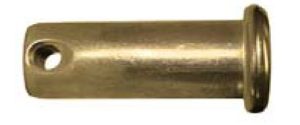
Clevis pins are versatile fasteners used in a wide variety of industries, including aerospace. They feature a head and shank — just like a standard bolt. Clevis pins, however, aren’t the same as bolts. Here are 5 facts about clevis pins and how they work.
#1) Commonly Used With a Cotter Pin
Clevis pins are commonly used with a cotter pin. When inspecting a clevis pin, you may notice a small hole at the end of the shank. This hole is designed to support a cotter pin. You can secure a cotter pin by placing a cotter pin through this hole. Just slide the cotter pin through the clevis pin’s hole and bend the ends. With the ends bent, the cotter pin won’t be able to slide out.
#2) Threaded and Unthreaded Styles
There are threaded and unthreaded clevis pins. Threaded clevis pins typically have a partially threaded shank. The shank has helical grooves covering about three-quarters of its surface. Unthreaded clevis pins, in comparison, have a completely smooth shank. Instead of helical grooves, they are smooth from the head to the end of the shank.
#3) Part of a Clevis Fastener System
Clevis pins are part of a two-piece fastener system known as a clevis fastener system. Clevis fastener systems consist of a clevis pin and a clevis. The clevis is a U-shaped component. At the end of the clevis is a pair of holes. You can run a clevis pin through these holes, after which you can place a cotter pin through the clevis pin’s hole. If the clevis pin is threaded, though, you won’t need to use a cotter pin. Threaded clevis pins will remain in place without the use of a cotter pin.
#4) Designed to Absorb Lateral Stress
Many people assume that clevis pins are the same as bolts and similar threaded fasteners, but this isn’t the case. They are typically stronger and more durable. When used in a clevis fastener system, clevis pins must be able to absorb lateral stress. They are exposed to pulling forces from the side. Bolts and other threaded fasteners may fail to withstand this lateral stress, making clevis pins a better choice for lateral stress-inducing applications such as this.
#5) Available in Cadmium-Plated Steel
You can find clevis pins in different materials, one of the most common being cadmium-plated steel. Cadmium-plated steel clevis pins are strong, durable and highly resistant to corrosion. They feature a steel core that’s able to withstand lateral stress. They are also coated in a layer of cadmium that protects the underlying steel from oxidation and, thus, corrosion.



